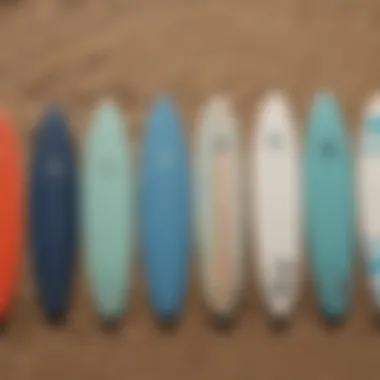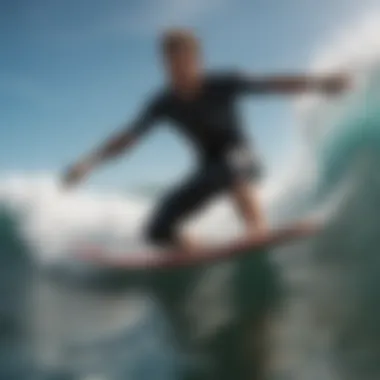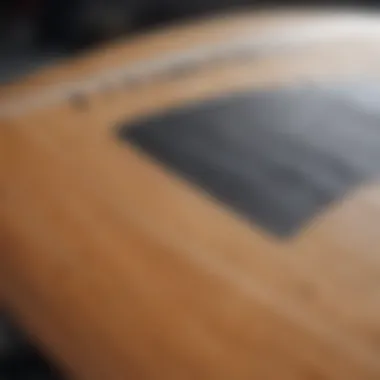The Ultimate Guide to Small Wave Surfboards


Intro
Surfing small waves presents a unique challenge and joy for enthusiasts, from novices to seasoned athletes. Understanding the best small wave surfboards is essential for enhancing performance and maximizing enjoyment in these conditions. This article explores crucial aspects that distinguish high-quality small wave surfboards, including their design, construction, and maintenance. With insights from user feedback and expert analysis, readers will be equipped with the knowledge to make informed decisions about their surfing gear. Whether one aims to improve technique or simply enjoy a fun day on the water, the right surfboard can significantly enhance the experience.
Understanding Small Wave Surfboards
Small wave surfboards are designed specifically for conditions where waves are less powerful and smaller in size. These boards typically feature a wider profile to help maintain stability and provide better paddle power. The key characteristics that define these boards include their length, width, and volume, each contributing to their overall performance in small conditions. Choosing the right small wave surfboard involves not just personal preference, but also an understanding of the board's capabilities in varied surf conditions.
A small wave surfboard should provide enough buoyancy and stability to ensure a smoother ride, even when the surf lacks punch.
Key Features of Small Wave Surfboards
There are several critical features to consider when selecting a small wave surfboard:
- Length and Width: Longer and wider boards tend to perform better in smaller waves. They provide more surface area, enhancing buoyancy and stability.
- Volume: Higher volume boards help maintain floatation, ensuring that surfers can catch waves more easily.
- Rockers: A moderate rocker allows for smoother transitions and turns while helping the board maintain speed in softer waves.
- Tail Shape: Different tail shapes affect maneuverability and speed. For small waves, a squash or rounded tail can be advantageous.
Selecting the Right Small Wave Surfboard
When selecting a small wave surfboard, surfers should consider their skill level, preferred wave conditions, and personal style. For beginners, a longer, wider board like the Soft Top Firewire can provide added stability. More experienced surfers might opt for a Channel Islands Fish, which offers better maneuverability. Trying different boards is advisable, as it helps in determining personal preferences.
Maintenance Tips
To prolong the life of small wave surfboards, proper care is essential. Here are some tips:
- Rinse After Use: Always rinse the board with fresh water after use to remove salt and sand.
- Store Properly: Avoid leaving the board in direct sunlight or extreme temperatures.
- Inspect for Damage: Regularly check for dings or cracks and repair them promptly to maintain performance.
End
Choosing the right small wave surfboard can enhance the surfing experience immensely. By understanding the key features, how they affect performance, and how to maintain these boards, surfers can ensure they are well-equipped for any small-wave conditions. This guide aims to provide valuable insights, making it easier for surfers to select gear that matches their skill level and style. With the right board beneath them, every surfer can embrace the fun and excitement that small waves have to offer.
Preamble to Small Wave Surfboards
Small waves are often considered the foundation of surfing, providing an entry point for beginners while remaining a favored choice for seasoned surfers seeking relaxation and fun. Understanding small wave surfboards becomes crucial as they cater specifically to these wave conditions. This means, any surfer aiming to optimize their performance in small surf must understand the unique designs and characteristics that define these boards.
Understanding Small Waves
Small waves typically refer to surf conditions that range from one to three feet. They are gentle and less intimidating, making them ideal for learners. Moreover, these waves allow for extended rides, which can enhance the learning curve. Understanding the dynamics of small waves is essential when choosing the right board.
Surfers quickly notice how wave performance can be affected by factors like wind, tide, and the seabed. Small waves can vary in shape, breaking either steep or soft. This variability demands a surfboard designed with appropriate floatation and stability to maximize enjoyment and minimize frustration.
Why Small Wave Surfboards Matter
Small wave surfboards hold significance not only for novices but also for experienced surfers who desire a versatile tool for all conditions. These boards are designed to maneuver effectively in limited wave energy, offering benefits such as stability and ease of paddling. Choosing the right small wave surfboard can transform a mediocre surf session into an enjoyable experience.
Small wave surfboards reduce the effort needed for paddling and allow the rider to catch more waves, making them advantageous for staying engaged during sessions. With the right board, surfers can practice skills and experiment with turns and tricks that may not be easily achievable in larger waves.
Key Features of Small Wave Surfboards
Understanding the key features of small wave surfboards is vital for anyone who wants to excel in less-than-ideal surf conditions. These boards are specifically designed for performance and functionality in smaller waves. Many factors contributed to the design and engineering of these boards, allowing surfers to maximize their ride and stay stable in less powerful surf. The right features will not only enhance the surf experience but also improve a rider's skill level over time.
Volume and Floatation
The volume of a surfboard is one of its most critical characteristics. It refers to how much space the board takes up, often measured in liters. This volume determines the floatation a board provides, significantly affecting overall performance. A higher volume means more buoyancy, allowing the surfer to paddle more effectively and catch waves with greater ease.
For small waves, having enough floatation helps surfers maintain speed and gain momentum, crucial for traversing flatter sections of the wave. If you are a beginner or someone who weighs more, picking a board with increased volume can lead to a more enjoyable experience. Additionally, boards with lower volume may suit advanced surfers who prefer more control and precision in their movements.


Length and Width Considerations
Length and width play essential roles in determining the overall performance of a small wave surfboard. Longer boards generally offer more stability and help in paddling, while shorter boards provide increased maneuverability. For small surf, some may prefer a slightly longer board to enhance paddling efficiency. In contrast, more experienced surfers may opt for shorter boards to perform more agile turns.
Width is equally important; a wider board provides more surface area, further enhancing floatation. However, a wider board can compromise speed and quick turns. When selecting the ideal dimensions, it's critical to strike a balance based on your preferences and skill level.
Rocker Profile Explained
The rocker profile refers to the curve of the surfboard from the nose to the tail. It is a crucial factor in how the board performs on waves. A board with less rocker has a flatter profile, offering more speed on smaller waves. This design allows for efficient paddling and quick entry into the wave.
In contrast, a board with more rocker is more curved, enhancing maneuverability and control in steeper sections of the wave. When surfing small waves, it can be beneficial to have a moderate rocker profile. This provides the right balance between speed and control. Therefore, understanding rocker characteristics is fundamental to selecting the right surfboard for optimal performance in small wave conditions.
Types of Small Wave Surfboards
Understanding the different types of small wave surfboards is crucial for both novice and experienced surfers. Each type has its unique characteristics that cater to specific surfing styles and conditions. Choosing the right surfboard can enhance performance in small waves, making your experience more enjoyable. The choice also affects how well you can practice skills such as paddling and maneuvering. Here, we analyze three prominent types of small wave surfboards: Fish Surfboards, Mini Longboards, and Funboards.
Fish Surfboards
Fish surfboards are distinguished by their wider tails and flatter rockers, which allow for better speed and stability in smaller waves. They often feature a swallow tail, which helps with quick response during turns. The design also promotes paddle power, enabling surfers to catch waves more efficiently.
Benefits of Fish Surfboards include:
- Speed: Their shape promotes fast riding, even in weaker surf.
- Maneuverability: The wider tail allows for abrupt changes in direction.
- Versatility: Fish boards can perform well in various conditions, making them a good option for recreational surfers.
For beginners, a fish surfboard provides stability and ease of use, while more skilled surfers can exploit the design for dynamic maneuvers. When considering a fish surfboard, it's essential to assess your skill level and the typical conditions at your local surf spots.
Mini Longboards
Mini longboards blend characteristics of traditional longboards and shortboards. Due to their length, they offer greater stability than shorter options. Mini longboards generally range between 7 to 8 feet, providing enough space for novice surfers to learn paddling and balance techniques.
Key advantages include:
- Stability: More surface area helps maintain balance, especially in smaller waves.
- Ease of Paddling: The longer length aids in generating momentum for catching waves.
- Nostalgic Riding Experience: Many surfers enjoy the traditional feel associated with longboards, even in smaller conditions.
Mini longboards are an ideal choice for various skill levels. For those transitioning from shortboards or who want to practice their longboarding skills, a mini longboard offers an excellent compromise between performance and ease.
Funboards
Funboards are often regarded as the ideal entry point for surfers who want to experience both short and long boards. They typically range from 7 to 8 feet in length, providing features of both categories, but in a package designed for fun and adaptability.
Features beneficial for surfers include:
- Hybrid Design: Combines elements from longboards and shortboards, promoting flexibility in wave riding.
- User-Friendly: They are easier to paddle and catch waves than traditional shortboards, which can be advantageous for beginners.
- Ideal for Smaller Waves: Funboards perform exceptionally well in small swells, allowing surfers to have fun regardless of conditions.
Funboards are particularly attractive to novice surfers searching for a versatile board they can grow with over time. They offer sufficient performance characteristics to allow progression, supporting improved skills and confidence.
Performance Characteristics
The performance characteristics of small wave surfboards play a significant role in how well a surfer can utilize their equipment in varying wave conditions. Understanding these aspects is crucial for both beginners and experienced surfers who seek to maximize their experience in small surf. Key elements include speed, paddle power, and stability, all of which impact how effectively a board responds to the water and the surfer's movements.
Speed and Maneuverability
Speed is vital for small wave surfboards as it allows surfers to generate momentum even in less powerful waves. A board that is designed for speed typically features a streamlined shape which reduces drag. This characteristic is essential for performing tricks and executing fluid turns.
When choosing a board, consider the following factors that affect speed and maneuverability:


- Rocker Profile: Less rocker often means faster rides. However, some rocker is necessary to avoid nose diving.
- Tail Shape: A wider tail can create more lift, aiding both speed and quick turns.
- Board Length: Shorter boards tend to be more maneuverable.
Increasing speed in small waves can elevate a surfer's experience, allowing for smoother rides and enhanced performance during sessions.
Paddle Power
Paddle power is essential for small wave surfing because it directly influences how easily a surfer can catch waves. Boards with increased volume and a wider outline typically offer better paddle power. When a board floats well, it enables the surfer to use less energy paddling and more efficiently catch incoming waves.
Key aspects to consider when evaluating paddle power in small wave surfboards include:
- Volume: A higher volume increases floatation, making it easier to catch waves.
- Width: A wider board provides more surface area for paddling, facilitating a quicker response in the water.
- Rails: Softer rails can create less drag, improving paddling efficiency.
Effective paddle power can lead to more wave catches, enhancing the overall experience, especially for surfers in less consistent surf conditions.
Stability on Smaller Waves
Stability becomes increasingly important when riding smaller waves. A stable board allows the surfer to maintain balance and control while navigating through less powerful surf. A board with proper width, volume, and a favorable design can significantly influence stability.
Consider these factors related to stability:
- Board Width: A broader board provides more surface area, improving balance.
- Tail Design: A wider tail can enhance stability during turns.
- Fin Setup: A proper fin configuration can dramatically affect stability on the water.
A stable small wave surfboard helps surfers to fine-tune their technique, providing more confidence while riding in challenging conditions. By understanding these performance characteristics, surfers can make informed decisions about which boards might best suit their needs.
Choosing the Right Small Wave Surfboard
Selecting the appropriate small wave surfboard is crucial for both performance and enjoyment on the water. Many factors come into play when making this decision, and understanding these elements can significantly enhance the surfing experience. An ill-suited board can hinder progress and dampen enthusiasm. The right surfboard not only matches the surfer's skill level but also accommodates personal preferences and physical attributes.
Benefits of Choosing the Right Surfboard
- Improved Performance: A well-fitted surfboard allows for better paddling, catching waves, and maneuvering, providing a smoother ride in small wave conditions.
- Increased Confidence: When surfers ride a board tailored to their abilities, it fosters greater confidence, encouraging them to tackle more complex maneuvers over time.
- Enhanced Enjoyment: Enjoyment comes from feeling comfortable and in control. The correct surfboard makes it easier to engage with the ocean and enjoy each experience.
Skill Level Considerations
Skill level is a fundamental aspect when choosing a small wave surfboard. Beginners tend to benefit from boards that offer high stability and ease of paddling, while more experienced surfers might prefer boards that allow for sharper turns and faster rides.
- Beginner Surfers: It is advisable to opt for a wider and thicker board, which provides stability and balance. For instance, a mini longboard can be a suitable option, giving novices the chance to learn without unnecessary difficulty.
- Intermediate Surfers: This group can experiment with different shapes and sizes to find a balance between maneuverability and stability. Funboards are popular in this category, allowing for playful rides on smaller waves.
- Advanced Surfers: Experts may prefer fish surfboards that facilitate high performance and fast turns, catering to their skills and ability to handle technical waves.
Body Type and Personal Preference
The surfer's body type plays an essential role in selecting the right surfboard. A board that complements the surfer’s physical characteristics can influence performance significantly.
- Weight: A heavier surfer might need a board with more volume to ensure buoyancy and balance, while lighter surfers can manage with less volume.
- Height: Taller surfers should consider longer boards to support their stance and weight distribution.
It is important also to take personal preference into account. Some surfers may favor a more laid-back ride, while others seek adrenaline-filled, aggressive maneuvers. Finding a surfboard that aligns with individual style enhances the overall surfing experience, fostering a deeper connection to the sport.
"The correct surfboard adapts to your abilities and desires, turning each surfing session into a memorable adventure."
By understanding and addressing these considerations, surfers can navigate the selection process more effectively and find a small wave surfboard that meets their needs. Forethought in this stage can lead to years of enjoyment in the water.
Top Rated Small Wave Surfboards
The section on top rated small wave surfboards is crucial for any surfer looking to maximize their enjoyment in smaller conditions. It provides insight into which boards stand out in terms of performance, durability and design. The right choice can enhance the surfing experience significantly. Small wave surfboards play a unique role because they aim to balance fun and functionality. Understanding top-rated options can therefore influence a surfer's decision when selecting their next board.
Brand Analysis


When evaluating small wave surfboards, brand reputation often carries substantial weight. Brands like Channel Islands, Firewire, and Lost are well-known within the surfing community. Each brand has its specific strengths and characteristics that appeal to various skill levels.
- Channel Islands: Known for their innovation and performance-oriented designs. Their boards often feature unique rocker lines which help with maneuverability in small waves.
- Firewire: This brand focuses on eco-friendly materials while providing high-performance surfboards. Their construction makes them lighter and more buoyant, appealing to many surfers.
- Lost: Their boards often deliver on performance for advanced surfers while also providing options for beginners. They are known for stylish designs and functional shapes.
The choice of brand can affect factors like warranty, customer service, and availability of parts. Brand loyalty often develops as surfers find the right match between their needs and the product offered.
Performance Reviews
Performance reviews offer an essential understanding of how different small wave surfboards behave in real situations. These reviews are influenced by user experiences and expert opinions, providing a rounded perspective on each model.
User Testimonials
User testimonials hold significant value when evaluating surfboards. When potential buyers see real users discussing their experiences, it brings a certain authenticity to their choices. Many surfers report improvements in their small wave riding ability after switching boards. The key characteristic of these testimonials is how they showcase individual preferences, from paddling ease to wave catching ability.
- Advantages: First-hand accounts can guide new buyers toward proven models. They often discuss nuances like how a board feels during rides.
- Disadvantages: Testimonials can be subjective. While one surfer may love a board's sturdiness, others might find it too heavy for their style.
Surfers should cross-reference several testimonials for a balanced view of any board's performance.
Expert Recommendations
This section is another vital part of understanding small wave surfboards. Experts often provide analysis based on extensive experience and industry knowledge. Reputable figures, such as pro surfers and surf coaches, offer insights into specific models they trust.
- Key Characteristic: Experts prioritize performance metrics and durability in their recommendations. They often highlight how particular brands or designs excel in different conditions, making it easier for users to select a board that meets their needs.
- Unique Feature: Recommendations usually consider environmental factors as well. Some experts will suggest models based on seasonal variations at given surf spots.
- Advantages: Reliable input can help inform novice surfers or those looking to make a switch.
- Disadvantages: As with testimonials, recommendations may reflect personal biases. Thus, checking multiple opinions is wise.
In summary, evaluations of top-rated small wave surfboards shed light on the best options. Factors like brand legacy, user feedback, and expert insights create a comprehensive guide for surfers. Choosing wisely can make a marked difference in enjoyment and performance on smaller waves.
Care and Maintenance of Surfboards
Caring for and maintaining your surfboard is crucial for its performance and longevity. For small wave surfboards, this is especially pertinent, as the design and materials are often tailored for specific conditions. By following proper care routines, surfers can ensure their boards remain in optimal shape, providing them with a better experience when hitting the waves. Surfboards can be significant investments, making it essential to take steps that will safeguard these assets over time.
Regular Cleaning Procedures
Keeping your surfboard clean is fundamental not only for maintaining its appearance but also for its performance. Sand, salt, and other debris can accumulate on the board's surface after a surf session. To clean your surfboard, follow these steps:
- Rinse the Board: After surfing, rinse the board with freshwater to remove salt and sand. This simple step helps prevent damage and fading.
- Use a Non-Abrasive Cleaner: Apply a mild surfboard cleaner or a mixture of water and vinegar. Avoid harsh chemicals as they can break down the board's finish.
- Soft Cloth Wipe: Use a soft cloth or sponge to gently scrub the board. Make sure to get into any crevices, especially around fins and tail pads.
- Dry Properly: Dry the board completely before storing it. This reduces the risk of moisture damage.
Regularly cleaning your surfboard not only preserves its aesthetic but also strengthens the material, reducing the likelihood of damage in the future.
Repair Techniques for Minor Damage
Minor damage to surfboards, such as scratches or small dings, can occur during use. Addressing these issues promptly can prevent more significant problems later. Here are some basic repair techniques:
- Identify the Damage: Inspect the board for any nicks or cracks. Knowing the scale of the damage will inform your repair approach.
- Gather Repair Materials: For minor repairs, you may need resin, fiberglass cloth, sandpaper, and some basic tools like a spatula.
- Clean the Area: Before any repair, ensure the area surrounding the damage is clean and dry. This ensures better adhesion of the repair materials.
- Apply Fiberglass and Resin: Cut a piece of fiberglass cloth to cover the damage. Mix the resin according to the manufacturer's instructions, then apply it over the cloth. Make sure it entirely covers the damaged area.
- Sand Smooth After Curing: Once the resin cures, sand down the area to make it smooth and level with the rest of the board.
"Timely repairs can extend the life of your surfboard significantly, ensuring better performance each time you surf".
By being proactive in maintenance, you not only enhance the longevity of your surfboard but also ensure that you have the best experience on the waves. Regular cleaning and minor repair techniques can go a long way toward keeping your equipment in peak condition.
Ending
The discussion surrounding small wave surfboards is crucial for both novice and experienced surfers. Understanding the nuances of these boards can significantly impact a rider’s experience on smaller waves. Small wave surfboards are not just tools; they are specially designed instruments that cater to the unique demands of weak or small surf conditions.
Recap of Key Points
To summarize the essential aspects covered in this article:
- Understanding Small Waves: Recognizing how small waves behave and their characteristics helps surfers to adjust their techniques and gear choices.
- Key Features of Small Wave Surfboards: Emphasizing volume, floatation, length, width, and rocker profile is vital in selecting the right board.
- Types of Surfboards: Each type, including Fish surfboards, Mini Longboards, and Funboards, has special features that serve distinct styles and preferences.
- Performance Characteristics: Factors like speed, maneuverability, and stability are essential for effective surfing in small conditions.
- Choosing the Right Board: Skill level and personal preferences are critical in making an informed decision.
- Maintenance: Regular care ensures longevity and performance of surfboards, which is often overlooked.
Final Thoughts on Small Wave Surfboarding
Surfing smaller waves can offer a unique and enjoyable experience when approached with the right equipment and mindset. Small wave surfboards enable surfers to maximize their sessions even in less than ideal conditions. Investing in a board that aligns with one’s skill level, body type, and personal style can elevate the overall surfing experience.
Moreover, understanding how to maintain and care for the surfboard extends its life and maintains optimum performance. The world of small wave surfing is not just for beginners; it presents challenges and opportunities for all skill levels.







